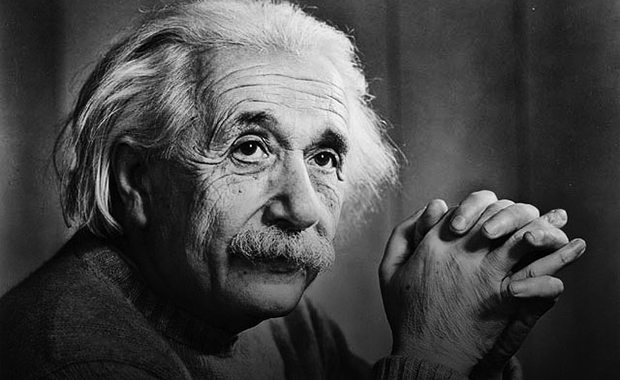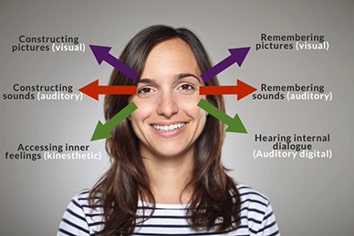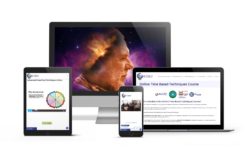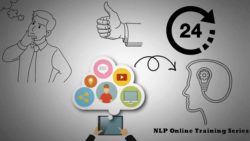What is the VAKOG?
In NLP training, we call the world that we express ourselves internally and externally, the VAKOG (visual, auditory, kinaesthetic, olfactory and gustatory). The latter two there refer to smell and taste. Later in this piece we give you a test to see what your preferences are..
Even if you haven’t undertaken NLP training in any form it’s easy to realise that people have very different ways of describing their world. From noticing the eye patterns and checking that people have varying ways of internalising information, we can begin to know that everybody has their own personal way of experiencing their world.
So how do we begin to recognize how each person makes sense of this unique world in which they live?
One of the easiest ways to discover this is to simply listen to the words that they’re using. In NLP, we call this the VAKOG, (the representation system), which stands for visual, auditory, kinaesthetic, olfactory, and gustatory. The other system, which also plays a part in this, we call self talk, the labeling system, or for short, Ai (audio internal).

According to NLP, for many practical purposes mental processing of events and memories can be treated as if performed by the five senses. For example, Einstein credited his discovery of spacial relativity to a mental visualization of “sitting on the end of a ray of light”, but many people as part of decision-making talk to themselves in their heads and won’t be making pictures at all. The manner in which this is done, and the effectiveness of the mental strategy employed, plays a critical part in the way mental processing takes place.
This observation led to the concept of a preferred representational system, the classification of people into fixed visual, auditory or kinaesthetic stereotypes.
This idea was later discredited and dropped within NLP by the early 1980s, in favour of the understanding that most people use all of their senses (whether consciously or unconsciously), and that whilst one system may seem to dominate, this is often contextualized – globally there is a balance that dynamically varies according to circumstance and mood.
NLP asserts that for most circumstances and most people, four of the five sensory based modes seem to dominate in mental processing:
* visual thinking – sight, mental imagery, spatial awareness
* auditory (or linguistic) – sound, speech, dialog, white noise
* kinaesthetic (or feelings) sense – somatic feelings in the body, temperature, pressure, and also emotion.
* self-talk (or audio internal)
The other two senses, gustatory (taste) and olfactory (smell), which are closely associated, often seem to be less significant in general mental processing, and are often considered jointly as one (possibly linked with feelings). Although most influential if you are hungry (for food or a person)!
The preferred representational system has been used in education since the 1970s. According to a survey in 1977, 99 percent of teachers believed that a student’s modality (the words that they use to describe part of the VAKOG) strengths and weaknesses should be considered and that a student learned more when instruction was modified to match preferred modality patterns.
Michael Grinder has written about learning styles from NLPs point of view in his book Righting the Educational Conveyor Belt, giving instructions of how to make the diagnosis with NLP tools such as observing eye movements.
Research on VAKOG
In an experiment outlined below, from Dissertation Abstracts International, author William Brockman, 1980, (using counselors to determine the experiment), some counselors were given the brief to match representational systems (VAKOG) and the other counselors took a more generic, human relations approach to empathy.
It was hypothesized that counselors who use representational system matching would: (1) be perceived by subjects as more empathetic than counselors who do not; (2) be perceived by judges as more empathetic than counselors who do not (accepted), (3) elicit a greater willingness to self- disclose than counselors who do not (rejected); and, (4) be preferred by clients over counselors who do not use representational matching.
Results indicate that both subjects and judges perceived the representational system matching counselor as more empathetic than the generic empathy counselor. Clients preferred the representational system matching counselor by a ratio of 3 to 1. It was concluded that representational system matching is an important dimension of empathy and the recommendation was made that beginning courses in counsellng techniques and human relations training include a section on identifying and responding to clients’ representational systems.
If you apply the same findings to the teaching arena, and you apply the same kind of results, it means that your pupils on a 3-1 ratio will find you empathetic to some degree!

Representational systems are also relevant since some tasks are more optimally performed within one representational system than by another. For example, within education, spelling is better learned by children who have unconsciously used a strategy of visualization, than an unconscious strategy of phonetically “sounding out” (see spelling strategies in this book). When taught to visualize, previously poor spellers can indeed be taught to improve. NLP proponents also found that pacing and leading the various cues tended to build rapport, and allowed people to communicate more effectively. Certain studies suggest that using similar representational systems to another person can help build rapport.
Skinner and Stephens (2003) explored the use of this model of representational systems in television marketing and communications.
And this will be no surprise to many of you. Just watch advertisements and notice how the advertising companies have discovered that using all the VAKOG in a short commercial will appeal to a wider audience than just one.
OK, perhaps it’s time for you to discover which system you prefer to use over another. Here’s a test for you:
REPRESENTATIONAL SYSTEM PREFERENCE TEST
For each of the following statements, please place a number next to every phrase. Use the following system to indicate your preferences:
4 = Closest to describing you
3 = Next best description
2 = Next best
1 = Least descriptive of you
1. I mostly make decisions about money based on:
____the right gut level feelings
____which is the best, sound solution and resonates for you
____what looks best to me after clearly seeing the images in question
____precise review and study of the situation
2. During an argument, I am most likely to be influenced by:
____the loudness or softness of the other person’s tone of voice
____whether or not I can see the other person’s point of view
____the logic of the other person’s argument
____whether or not I am in touch with mine and the other person’s feelings
3. I mostly like to be aware of the following in conversation:
____the way people hold themselves and interesting facial expressions
____the feelings that we share
____the words I and they choose and whether it all makes good sense
____the sounds and intonations that come from the tone of voice
4. If I had the choice of these in order, first I would like to:
____find the ideal volume and tuning on a stereo system
____select the most intellectually relevant point in an interesting subject
____select the most comfortable furniture
____look around and take in the décor, pictures and how the room looks before doing anything else
5. Which describes your room that you live in:
____The hi-fi is very prominent and you have an excellent CD/MP3 collection
____It’s a practical layout and things are situated in an excellent location
____The feel of the place is the most important to you
____The colours you choose and the way a room looks are most important
REP SYSTEM TEST
Step One: Copy your answers from the previous page to here:
1. ____K 2.___A 3. ____V
____A ____V ____K
____V __Ai ____Ai
____Ai ____K ____A
4.____A 5.____A
____Ai ____Ai
____K ____K
____V ____V
Step two: Aid the numbers associated with each letter. There are 5 entries for each letter:
V A K Ai
1 — — — —
2 — — — —
3 — — — —
4 — — — —
5 — — — —
Totals:
Step three: The comparison of the total scores in each column will give the relative preference for each of the 4 major Representational Systems.
This test is a very simple and generalized indication and by no means definitive.
Here’s another way of finding out your preferences:
If I was to give you the latest, state of the art DVD player with new features on it and it was your responsibility to make it work, would you:
- A) Grab the manual and read it avidly
- B) Take the articles out of the box and get to grips with it as you go
- C) Talk to someone else about setting it up?
So if you answered A, then that’s your visual preference, B would be the tactile or kinaesthetic approach and C the auditory way.
Again, these are not cast in stone, as they may change in differing contexts.
To aid you in recognizing differing internal word processing, here are words (often known as predicates in the NLP world) that you’ll find people using when externalizing their internal world.
VISUAL AUDITORY KINAESTHETIC Auditory Internal
V: Visual
People who are visual often stand or sit with their heads and/or bodies erect, with their eyes up. They will be breathing from the top of their lungs. They often sit forward in their chair and tend to be organized, neat, well-groomed and orderly. They memorize by seeing pictures, and are less distracted by noise. They often have trouble remembering verbal instructions because their minds tend to wander. A visual person will be interested in how your program LOOKS. Appearances are important to them. They are often thin and wiry.
A: Auditory
People who are auditory will move their eyes sideways (remember Richard Nixon?). They breathe from the middle of their chest. They typically talk to themselves, and are easily distracted by noise, (some even move their lips when they talk to themselves.) They can repeat things back to you easily, they learn by listening, and usually like music and talking on the phone. They memorize by steps, procedures, and sequences (sequentially). The auditory person likes to be TOLD how they’re doing, and responds to a certain tone of voice or set of words. They will be interested in what you have to SAY about your program.
K: Kinaesthetic
People who are kinaesthetic will typically be breathing from the bottom of their lungs, so you’ll see their stomach go in and out when they breathe. They often move and talk verrry slooowly. They respond to physical rewards, and touching. They also stand closer to people than a visual person. They memorize by doing or walking through something. They will be interested in your program if it FEELS RIGHT.
Ai: Auditory Internal (self talk)
This person will spend a fair amount of time talking to themselves. They will want to know if your program MAKES SENSE, is it logical, follows a structure etc. The auditory internal person can exhibit characteristics of the other major representational systems.
We train all of the skills above on out NLP Practitioner and NLP Master Practitioner courses.



